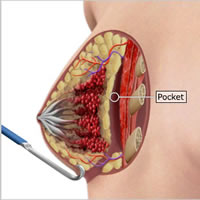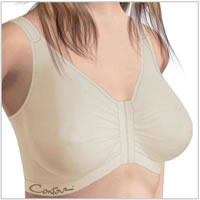 Breast augmentation, or augmentation mammoplasty, is one of the most common plastic surgery procedures performed today. Over time, factors such as age, genetics, pregnancy, weight changes, sun exposure, and gravity can cause the size and shape of the breast to change. Women who are dissatisfied with the size of their breasts, or have experienced changes in breast appearance can achieve a fuller, shapelier breast with breast augmentation. During breast augmentation, a breast implant is placed inside a pocket formed in the breast tissue. This can help to increase or balance the size of the breast, restore breast volume, or restore the shape of the breast after partial or total loss. It is important to realize that breast augmentation cannot correct significantly sagging or drooping breasts. In these instances, a breast lift is often necessary, which may be performed in conjunction with this procedure.
Breast augmentation, or augmentation mammoplasty, is one of the most common plastic surgery procedures performed today. Over time, factors such as age, genetics, pregnancy, weight changes, sun exposure, and gravity can cause the size and shape of the breast to change. Women who are dissatisfied with the size of their breasts, or have experienced changes in breast appearance can achieve a fuller, shapelier breast with breast augmentation. During breast augmentation, a breast implant is placed inside a pocket formed in the breast tissue. This can help to increase or balance the size of the breast, restore breast volume, or restore the shape of the breast after partial or total loss. It is important to realize that breast augmentation cannot correct significantly sagging or drooping breasts. In these instances, a breast lift is often necessary, which may be performed in conjunction with this procedure.Cosmetic Surgery 3D Animation Printable Brochures
 Breast augmentation, or augmentation mammoplasty, is one of the most common plastic surgery procedures performed today. Over time, factors such as age, genetics, pregnancy, weight changes, sun exposure, and gravity can cause the size and shape of the breast to change. Women who are dissatisfied with the size of their breasts, or have experienced changes in breast appearance can achieve a fuller, shapelier breast with breast augmentation. During breast augmentation, a breast implant is placed inside a pocket formed in the breast tissue. This can help to increase or balance the size of the breast, restore breast volume, or restore the shape of the breast after partial or total loss. It is important to realize that breast augmentation cannot correct significantly sagging or drooping breasts. In these instances, a breast lift is often necessary, which may be performed in conjunction with this procedure.
Breast augmentation, or augmentation mammoplasty, is one of the most common plastic surgery procedures performed today. Over time, factors such as age, genetics, pregnancy, weight changes, sun exposure, and gravity can cause the size and shape of the breast to change. Women who are dissatisfied with the size of their breasts, or have experienced changes in breast appearance can achieve a fuller, shapelier breast with breast augmentation. During breast augmentation, a breast implant is placed inside a pocket formed in the breast tissue. This can help to increase or balance the size of the breast, restore breast volume, or restore the shape of the breast after partial or total loss. It is important to realize that breast augmentation cannot correct significantly sagging or drooping breasts. In these instances, a breast lift is often necessary, which may be performed in conjunction with this procedure.Implant Options
 Re-approved by the FDA in 2006, silicone implants are made of a silicone rubber shell and are filled with silicone gel. There is no significant evidence that suggests silicone implants increase your risk for breast cancer, connective tissue disorders, or autoimmune disease.
Re-approved by the FDA in 2006, silicone implants are made of a silicone rubber shell and are filled with silicone gel. There is no significant evidence that suggests silicone implants increase your risk for breast cancer, connective tissue disorders, or autoimmune disease.
Breast implants differ by shape, texture, and profile. Breast implants may be round or contoured, and may have a smooth or textured surface. The breast implant profile may be standard, moderate, or high. Lastly, breast implants vary by size, or volume. The type, style, and size of breast implants you choose are determined by your lifestyle, body contours, the amount of breast tissue you have, and the cup size and appearance that you would like to achieve. Be sure to talk with your doctor in depth about choosing the breast implant option that is right for you.
What Gives the Breast its Shape?
 The breast consists of glands and milk ducts, surrounded by fatty tissue which provides its shape and soft form. The elasticity of your skin also contributes to its shape. As you know, certain factors such as age and pregnancy can affect the elasticity of your skin and breast tissue, which results in changes to shape and appearance.
The breast consists of glands and milk ducts, surrounded by fatty tissue which provides its shape and soft form. The elasticity of your skin also contributes to its shape. As you know, certain factors such as age and pregnancy can affect the elasticity of your skin and breast tissue, which results in changes to shape and appearance.
Breast implants can be placed in two general locations, known as submuscular and subglandular placement. Submuscular placement refers to an implant that is placed partially or completely beneath the pectoralis muscle, against the chest wall. In contrast, subglandular placement refers to an implant that is placed beneath the breast tissue, but above the pectoralis muscle. Your surgeon will help determine the implant placement that is best for you.
Under the Breast Technique Step 1
 Breast augmentation procedures typically last approximately one to two hours. Prior to the start of your procedure the treatment area will be thoroughly cleansed and an anesthetic will be administered. Depending on the surgeon’s preferences and the nature of the procedure, a local anesthetic in combination with intravenous sedation or general anesthesia will be used.
Breast augmentation procedures typically last approximately one to two hours. Prior to the start of your procedure the treatment area will be thoroughly cleansed and an anesthetic will be administered. Depending on the surgeon’s preferences and the nature of the procedure, a local anesthetic in combination with intravenous sedation or general anesthesia will be used.
The inframammary incision is placed along the crease of the lower portion of the breast. A single, small incision is made along each breast. Using an instrument known as a retractor, the surgeon will open the incision in order to gain better access to the breast tissue below. Although the incision will be made as inconspicuously as possible, its length and appearance may vary depending on the type and size of implant, your body contours, and the surgeon’s preference.
Under the Breast Technique Step 2
 The surgeon will carefully separate the breast tissue with a minimally invasive cautery device and a scalpel, in order to reach the area of the breast in which the pocket will be formed. Using an instrument known as an elevator and their fingers, the surgeon will carefully create a pocket in which to place the breast implant.
The surgeon will carefully separate the breast tissue with a minimally invasive cautery device and a scalpel, in order to reach the area of the breast in which the pocket will be formed. Using an instrument known as an elevator and their fingers, the surgeon will carefully create a pocket in which to place the breast implant.
Under the Breast Technique Step 3
![]() Unlike saline implants, which are usually inserted empty, silicone implants are pre-filled. As silicone implants are pre-filled, they generally require a slightly larger incision than saline implants. The surgeon will insert the implant into the pocket and visually inspect your breasts to ensure that they are symmetric. They may adjust the pocket and the position of the breast implant itself to ensure that the desired look is achieved.
Unlike saline implants, which are usually inserted empty, silicone implants are pre-filled. As silicone implants are pre-filled, they generally require a slightly larger incision than saline implants. The surgeon will insert the implant into the pocket and visually inspect your breasts to ensure that they are symmetric. They may adjust the pocket and the position of the breast implant itself to ensure that the desired look is achieved.
Under the Breast Technique Step 4
![]() The incisions will be closed using sutures in the breast tissue. Sutures, skin adhesive or surgical tape may be used to close the skin. Your surgeon may choose to use non-dissolving sutures, which will be removed in seven to ten days. The scars from the incisions will fade slowly over several months, but it may take up to a year for them to refine completely. As with any surgery, you will most likely experience some pain and swelling after surgery. The majority of the swelling will likely subside within a few days. However, some swelling may persist for several weeks.
The incisions will be closed using sutures in the breast tissue. Sutures, skin adhesive or surgical tape may be used to close the skin. Your surgeon may choose to use non-dissolving sutures, which will be removed in seven to ten days. The scars from the incisions will fade slowly over several months, but it may take up to a year for them to refine completely. As with any surgery, you will most likely experience some pain and swelling after surgery. The majority of the swelling will likely subside within a few days. However, some swelling may persist for several weeks.
Compression Garment Overview
 Your physician may place you in a special bra or compression garment to aid in the healing process. Compression garments provide support and comfort, minimize swelling, and help to maintain the position of the implants. This is why it is important that you wear the compression garment as recommended by your physician.
Your physician may place you in a special bra or compression garment to aid in the healing process. Compression garments provide support and comfort, minimize swelling, and help to maintain the position of the implants. This is why it is important that you wear the compression garment as recommended by your physician.
Under the Breast Technique Summary
![]() You will most likely be able to return to work within three to seven days after your procedure. However, it is important that you avoid any strenuous activity and lifting for approximately three to four weeks. Doing so may delay healing and could damage the implants. You will be able to notice the final results from your procedure once the implants have settled and the swelling has subsided completely.
You will most likely be able to return to work within three to seven days after your procedure. However, it is important that you avoid any strenuous activity and lifting for approximately three to four weeks. Doing so may delay healing and could damage the implants. You will be able to notice the final results from your procedure once the implants have settled and the swelling has subsided completely.
It is important to realize that your breasts will continue to change shape over time. However, the results from breast augmentation are typically long-lasting, which means that your breasts will maintain the fuller, shapelier appearance that you desire for years to come.
Orange County Breast Implants by AesthetiCare
Ronald Moser M.D. is the surgical director for AesthetiCare Cosmetic Surgery Institute based in Southern California. He has been in practice for nearly 30 years and has performed more than 16,000 surgical procedures.
